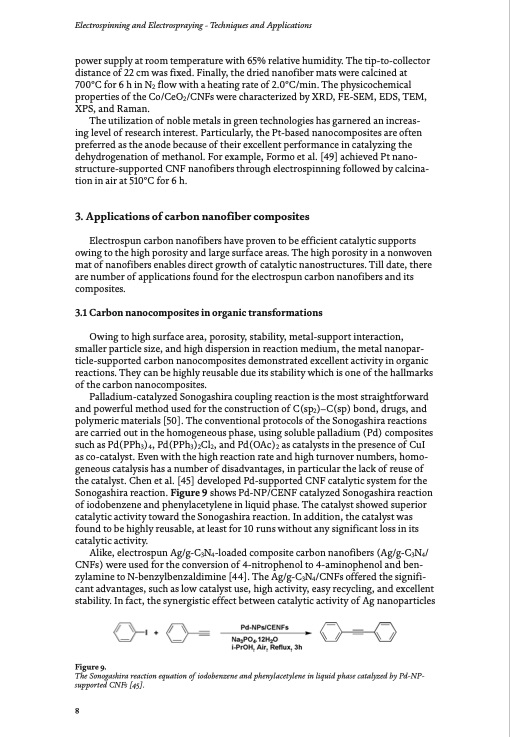
PDF Publication Title:
Text from PDF Page: 008
Electrospinning and Electrospraying - Techniques and Applications power supply at room temperature with 65% relative humidity. The tip-to-collector distance of 22 cm was fixed. Finally, the dried nanofiber mats were calcined at 700°C for 6 h in N2 flow with a heating rate of 2.0°C/min. The physicochemical properties of the Co/CeO2/CNFs were characterized by XRD, FE-SEM, EDS, TEM, XPS, and Raman. The utilization of noble metals in green technologies has garnered an increas- ing level of research interest. Particularly, the Pt-based nanocomposites are often preferred as the anode because of their excellent performance in catalyzing the dehydrogenation of methanol. For example, Formo et al. [49] achieved Pt nano- structure-supported CNF nanofibers through electrospinning followed by calcina- tion in air at 510°C for 6 h. 3. Applications of carbon nanofiber composites Electrospun carbon nanofibers have proven to be efficient catalytic supports owing to the high porosity and large surface areas. The high porosity in a nonwoven mat of nanofibers enables direct growth of catalytic nanostructures. Till date, there are number of applications found for the electrospun carbon nanofibers and its composites. 3.1 Carbon nanocomposites in organic transformations Owing to high surface area, porosity, stability, metal-support interaction, smaller particle size, and high dispersion in reaction medium, the metal nanopar- ticle-supported carbon nanocomposites demonstrated excellent activity in organic reactions. They can be highly reusable due its stability which is one of the hallmarks of the carbon nanocomposites. Palladium-catalyzed Sonogashira coupling reaction is the most straightforward and powerful method used for the construction of C(sp2)–C(sp) bond, drugs, and polymeric materials [50]. The conventional protocols of the Sonogashira reactions are carried out in the homogeneous phase, using soluble palladium (Pd) composites such as Pd(PPh3)4, Pd(PPh3)2Cl2, and Pd(OAc)2 as catalysts in the presence of CuI as co-catalyst. Even with the high reaction rate and high turnover numbers, homo- geneous catalysis has a number of disadvantages, in particular the lack of reuse of the catalyst. Chen et al. [45] developed Pd-supported CNF catalytic system for the Sonogashira reaction. Figure 9 shows Pd-NP/CENF catalyzed Sonogashira reaction of iodobenzene and phenylacetylene in liquid phase. The catalyst showed superior catalytic activity toward the Sonogashira reaction. In addition, the catalyst was found to be highly reusable, at least for 10 runs without any significant loss in its catalytic activity. Alike, electrospun Ag/g-C3N4-loaded composite carbon nanofibers (Ag/g-C3N4/ CNFs) were used for the conversion of 4-nitrophenol to 4-aminophenol and ben- zylamine to N-benzylbenzaldimine [44]. The Ag/g-C3N4/CNFs offered the signifi- cant advantages, such as low catalyst use, high activity, easy recycling, and excellent stability. In fact, the synergistic effect between catalytic activity of Ag nanoparticles Figure 9. The Sonogashira reaction equation of iodobenzene and phenylacetylene in liquid phase catalyzed by Pd-NP- supported CNFs [45]. 8PDF Image | Preparation, Characterization, and Applications of Electrospun Carbon Nanofibers

PDF Search Title:
Preparation, Characterization, and Applications of Electrospun Carbon NanofibersOriginal File Name Searched:
68337.pdfDIY PDF Search: Google It | Yahoo | Bing
Sulfur Deposition on Carbon Nanofibers using Supercritical CO2 Sulfur Deposition on Carbon Nanofibers using Supercritical CO2. Gamma sulfur also known as mother of pearl sulfur and nacreous sulfur... More Info
CO2 Organic Rankine Cycle Experimenter Platform The supercritical CO2 phase change system is both a heat pump and organic rankine cycle which can be used for those purposes and as a supercritical extractor for advanced subcritical and supercritical extraction technology. Uses include producing nanoparticles, precious metal CO2 extraction, lithium battery recycling, and other applications... More Info
| CONTACT TEL: 608-238-6001 Email: greg@infinityturbine.com | RSS | AMP |